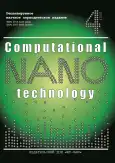Control System for Waterjet Cutting Process with Swirling Working Fluid Jet
- Authors: Ivanov V.V.1, Kalashnikov E.A.1
-
Affiliations:
- National Research Technological University “MISiS”
- Issue: Vol 10, No 4 (2023)
- Pages: 63-71
- Section: AUTOMATION OF MANUFACTURING AND TECHNOLOGICAL PROCESSES
- URL: https://journals.rcsi.science/2313-223X/article/view/251952
- DOI: https://doi.org/10.33693/2313-223X-2023-10-4-63-71
- ID: 251952
Cite item
Abstract
In mechanical engineering, the procurement process is one of the most important in the life cycle stage of manufacturing products from metal materials. In this regard, there are disadvantages in the manufacture of parts: low productivity, complexity and high cost of cutting tools, and the impossibility of cutting. The work proposes an approach to increase the productivity of using the cutting properties of abrasive grains and expanding the contact area of a waterjet jet with the workpiece surface being processed by twisting the jet and adjusting the values of the jet oscillation frequency to the thickness of the workpiece. As a result of research verification, the approach showed good prediction accuracy.
Full Text
##article.viewOnOriginalSite##About the authors
Viktor V. Ivanov
National Research Technological University “MISiS”
Author for correspondence.
Email: viktor_ivanov_61@mail.ru
ORCID iD: 0000-0002-1264-313X
postgraduate student, Department of Infocommunication Technologies
Russian Federation, MoscowEvgeniy A. Kalashnikov
National Research Technological University “MISiS”
Email: e.a.kalashnikov@mail.ru
Cand. Sci., associate professor, Department of Infocommunication Technologies
Russian Federation, MoscowReferences
- Ivanov V.V., Ivanov S.V., Ivanov Vl.V. Simulation experimental studies of the amount of metal removal from waterjet processing modes using information technologies. Computational Nanotechnology. 2015. No. 4. Pp. 74–78. (In Rus.)
- Ivanov V.V., Kalashnikov E.A., Bakradze L.G. Control system for the waterjet cutting process. Path of Science. International Scientific Journal. 2023. No. 5 (111). Pp. 24–27. (In Rus.)
- Ivanov V.V., Ivanov S.V. A program for calculating and constructing an optimal technological process for waterjet cutting by swirling a jet of working fluid. Certificate of state registration of the computer program No. 2020617624, 07/08/2020.
- Ivanov V.V. Development of an automated software and hardware complex for intelligent support and optimal configuration of waterjet machines with numerical control. Computational Nanotechnology. 2015. No. 2. Pp. 55–61. (In Rus.)
- Ivanov V.V., Vasin A.N., Iznairov B.M. Method of waterjet processing with jet oscillation. Pat. 2688007 of Russian Federation No. 2017143280, 12/11/2017. Publ. 05/17/2019. Bull. No. 14.
- Korolev A.V. Study of the formation processes of tool and part surfaces during abrasive processing. Saratov: Publishing House of the Saratov University. 1975. 191 p.
- Shpilev V.V., Reshetnikov M.K. Modeling of a heterogeneous jet during waterjet cutting. Bulletin of the Saratov State Technical University. 2011. No. 3 (58). Pp. 154–158. (In Rus.)
- Shpilev V.V., Reshetnikov M.K., Bereda N.N. Modeling of a swirling waterjet jet during waterjet cutting. Bulletin of the Saratov State Technical University. 2011. No. 2 (56). P. 163–168. (In Rus.)
Supplementary files




















